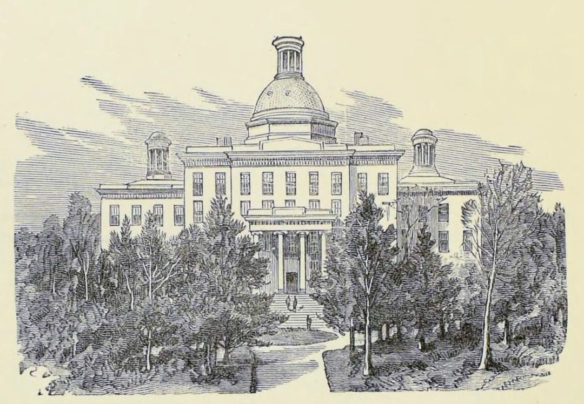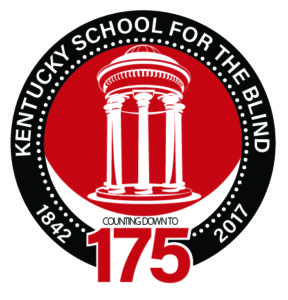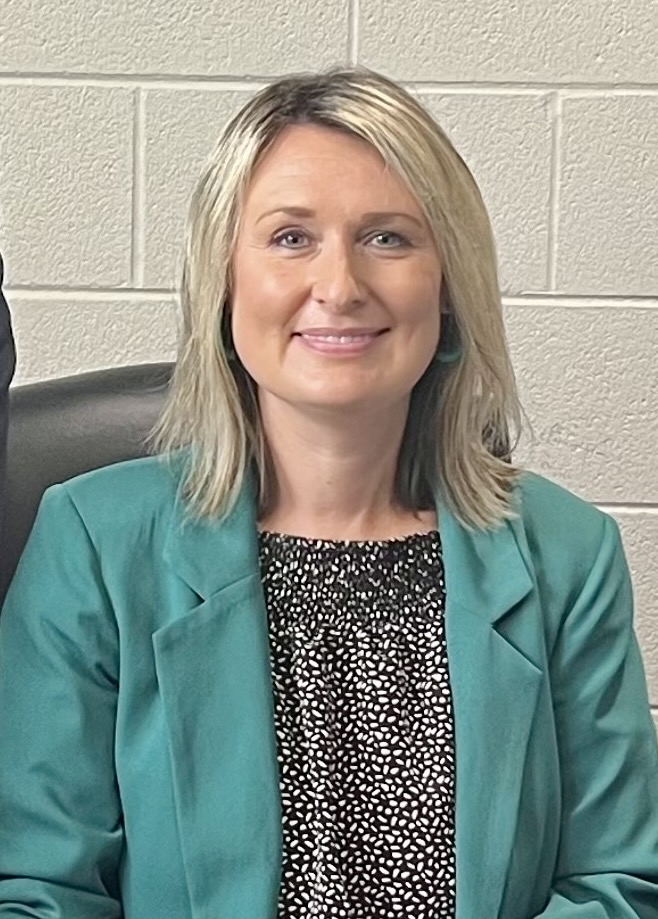
This sketch shows what the Kentucky School for the Blind looked like in 1884, when the school already was 42 years old. The school is celebrating its 175th year of serving Kentucky students with visual impairments.
Submitted photo
Each May the Kentucky School for the Blind (KSB) celebrates Founder’s Day, an event that commemorates its rich history of providing educational services to Kentucky students who are blind and visually impaired.
This year’s event is especially significant because the school – which opened its doors to five students in 1842 – is celebrating its 175th anniversary.
Set back from Frankfort Avenue in the Clifton neighborhood, KSB’s peaceful, green campus belies the school’s significance and importance to the students, families and the 120 Kentucky counties it serves.
The Kentucky School for the Blind’s commitment to children who are blind or visually impaired has been unwavering since its founding. Its staff does whatever it takes to provide students with the educational access and opportunities they need to succeed once they make their way into the world as adults.
 KSB is more than a school though; it is a community that advocates for those it serves and has served. It stands as a testament to the past and future contributions of men and women who are blind and visually impaired, and the belief that while visual deficits may pose challenges they do not define, nor do they squelch possibilities and dreams. Its alumni and supporters – among the school’s staunchest ambassadors – readily share that belief.
KSB is more than a school though; it is a community that advocates for those it serves and has served. It stands as a testament to the past and future contributions of men and women who are blind and visually impaired, and the belief that while visual deficits may pose challenges they do not define, nor do they squelch possibilities and dreams. Its alumni and supporters – among the school’s staunchest ambassadors – readily share that belief.
As KSB alumnus and teacher Brian Mullins so eloquently puts it: “Without KSB I would not be a college graduate, I would not be employed, I would not be a homeowner, I would not be a coach, I would not be much of anything and I probably would not be alive today.”
The school is so much a part of the fabric of Louisville, it is easy to drive by its stone-walled campus and not recognize its immense historical and educational significance.
In his book, A History of Education in Kentucky (2011), William Ellis credits Kentucky as one of the first states to provide education for the blind. KSB was, in fact, the third state-supported school for the blind in the United States.
The school’s founder and president of the Louisville Collegiate Institute, Bryce McLellan Patten, along with his brother, Otis, began teaching a class of six blind students in the summer of 1839. In early 1841, in an effort to attain funding for a school for the blind, Otis Patten presented an exhibition of his blind students’ skills before the Kentucky General Assembly. The brothers’ request for funding proved unsuccessful that session, but they remained undeterred. A year later, they invited Dr. Samuel Gridley Howe, founder and director of the Perkins School for the Blind in Massachusetts, and his students to Kentucky to make a presentation to state lawmakers. Howe and his students proved convincing, and on Feb. 5, 1842, the Kentucky Institution for the Blind was chartered with an appropriation of $10,000.
The school opened in May 9, 1842, in a rental home on Sixth Street between Chestnut and Walnut streets in downtown Louisville. After outgrowing several buildings in the area, a permanent school home was built on Broadway Avenue in 1845. The building burned in 1851 and the decision was made to move the school out of the city. A tract of land known as the Frankfort Turnpike Road (now Frankfort Avenue) was purchased and a new school built on it in 1855. In 1967, that building was razed to make way for a modern facility that would better serve students with visual impairments.
Other historical and educational highlights from the school’s history include:
- After the Battle of Perryville, the Federal army medical director ordered the school to vacate in October 1862 and the building was used as a hospital during the Civil War. Under pressure by school trustees, the War Department forced hospital personnel out and students returned on March 17, 1863.
- The American Printing House for the Blind (chartered in 1858) began operating in the basement of the school and the first book was printed in 1869. Superintendent Bryce Patten served as superintendent of both the school and the printing house.
- The Colored School for the Blind, built on Haldeman Avenue adjacent to the Kentucky Institution for the Blind, opened in October 1884. That school merged with KSB in 1955.
- In 1910, the Kentucky Institution for the Blind formed Boy Scout Troop 10. Still active today, it is the first troop in U.S. serving students with disabilities.
- In 1916, the name of the school changed to Kentucky School for the Blind.
- In 1917, former KSB student Gladys Knight graduated from the University of Louisville, the first blind person in Kentucky to do so.
- KSB aligned curriculum to meet state requirements in 1931 and issued Kentucky high school diplomas for the first time to 15 graduates in 1933.
- In 1946, Superintendent Paul J. Langan negotiated with public schools to allow KSB students to attend high school during their junior and senior years with sighted students. In 1950, boys went to Male High School and girls attended Halleck Hall (now duPont Manual High School).
- In 1953, the Louisville Downtown Lions Club provided a Christmas Party and dinner for KSB students, a tradition that continues today.
- Will D. Evans, a KSB alumnus, was hired as teacher in 1967 and served as Superintendent from 1974-95. Under his leadership, KSB experienced a five-building, 20-year development on campus.
- The school established its Low Vision Program in 1990, providing low vision evaluations statewide for Kentucky students with visual impairments.
- The Short Term Program for students who are blind and visually impaired was established in 1993, allowing students to attend KSB 1-12 weeks a year for specialized instruction while staying enrolled in their home school district.
- In 1994, the schools began offering Gateways to Independence Professional Development Training to Kentucky teachers of the visually impaired.
- In 1996, the Kentucky Legislature designated KSB as the statewide educational resource center on blindness.
- In 1996, KSB revamped Outreach Services and placed consultants in regional sites to support proficient student performance by assisting local school districts in reducing barriers to learning associated with a vision loss.
- KSB established the Insight Post-Secondary Preparation Program in 2006. Held during the summer at Morehead State University, this program provides high school students who are blind and visually impaired with an opportunity to experience what it is like to enter and navigate in a post-secondary setting.
Today, KSB enrolls 63 residential students, and provides outreach to more than 1,600 blind and visually impaired students in the Commonwealth. While on campus, students are taught the same core curriculum as their sighted peers and receive instruction in the expanded curriculum on such topics as travel, independent living, visual efficiency skills and more. The school also provides Braille and large-type textbooks, assistive and adaptive technology, specialized educational aids, low vision services, and assistance to all of Kentucky’s 173 school districts.
From its beginnings, KSB’s mission has been to help all Kentucky students who are blind and visually impaired to develop their talents, their skills and their attitudes to become confident, competent and independent adults. That work and commitment has been its bedrock for 175 years and continues today.
Students, teachers, alumni, parents and supporters have a lot to be proud of during this year’s Founders’ Day celebration on May 9. But so, too, do the citizens of Louisville and Kentucky. KSB’s tradition and the Commonwealth’s commitment to providing a world-class education to all students so they can reach their goals and be engaged citizens endures. That is a feat worth celebrating and a commitment worth keeping for years to come.



Leave A Comment